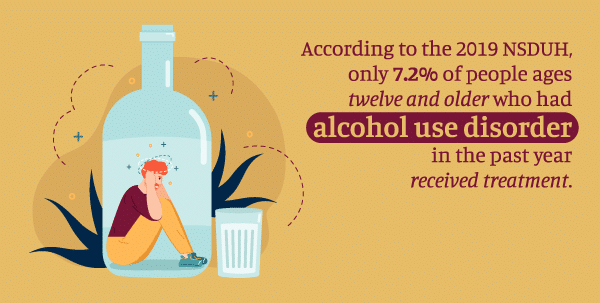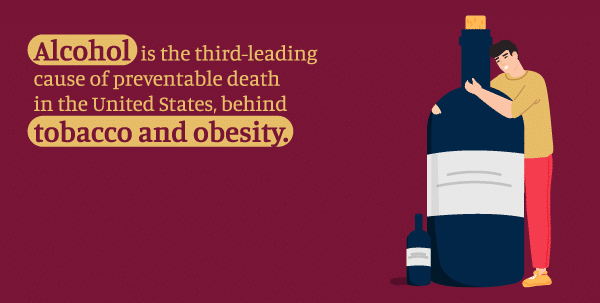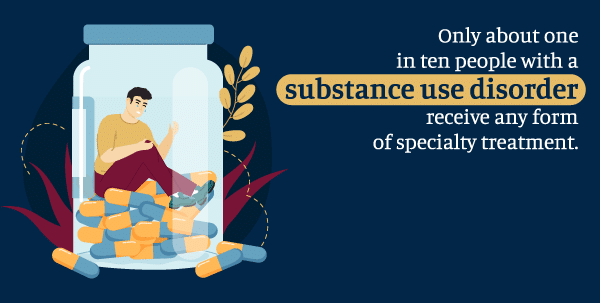Drug and Alcohol Intervention Guide
This article is a detailed guide for the drug or alcohol addiction intervention process.

Drug and Alcohol Intervention Guide
This article is a detailed guide for the drug or alcohol addiction intervention process.
Table of Contents
What Is an Intervention?

Being a family member or close friend of someone struggling with a substance use disorder can be very disheartening. If you live in the same house or see them regularly, you’re likely to notice evidence of substance abuse. You may even be on the receiving end of emotional or physical abuse or experience financial problems or increased stress due to your loved one’s condition.
If substance use disorder (SUD) continues untreated, problems will likely increase. As a result, the person may begin to have significant health issues or trouble maintaining their daily routine. For example, their interest in activities they once enjoyed may decline, or they may experience legal problems such as jail time, probation, or loss of driving privileges.
Understanding Interventions
The Impact of Substance Abuse
Clearly, family and friends don’t want to see their loved ones experience these issues, nor do they want to suffer themselves. Oftentimes, the best option is for the person with a substance use disorder to seek treatment.
However, most won’t initiate getting treatment independently and will require some external motivation or encouragement. In some cases, the best chance of getting your loved one to treatment is staging a drug or alcohol intervention.
An intervention is a planned process that often involves people who care about those struggling with addiction.1 These events are usually organized by close friends or family members. Some people call on doctors or professional substance abuse interventionists to help.
Is Drug Intervention Necessary?

If there are clear indications that a family member or friend is abusing drugs, it’s essential to act quickly. Drug abuse can become a habit in just a few weeks and lead to severe consequences for the person affected. Warning signs of drug or alcohol abuse include:2
- Using or drinking larger amounts or over longer periods than planned
- Continually wanting or unsuccessfully trying to cut down or manage the use of drugs or alcohol
- Spending a lot of time getting, using, or recovering from drugs or alcohol
- Ongoing drug or alcohol use that interferes with work, school, or home duties
- Using drugs or alcohol, even with continued relationship problems (often caused by use)
- Giving up or reducing activities because of drug or alcohol use
- Taking risks, such as sexual risks or driving under the influence
- Continually using drugs or alcohol, even if substance use adds to physical or psychological problems
- Developing a tolerance or the need to use more drugs or alcohol to get the same effect
- Having withdrawal symptoms if not using drugs or alcohol
Does your close friend or family member exhibit these symptoms but refuse to acknowledge or admit having a problem? Then, a drug intervention may be necessary to get them the treatment they need.
What Happens During an Intervention?
During a drug intervention, the people involved confront the individual about their substance use and urge them to seek treatment. Common areas of focus can include:
- Specific examples where substance abuse has led to destructive behavior
- A prearranged treatment plan with defined goals
- What each person will do if the person refuses to accept treatment
A drug intervention can be an emotional and terrifying experience for the person with the substance use disorder. It is critical to keep this in mind and be ready for any potential issues.
When to Intervene for a Loved One

A drug abuse intervention may be necessary if a substance use disorder begins to impact your loved one’s life or the lives of friends and family members. Staging interventions early on when substance use disorder symptoms first appear often leads to better success.
An individual who has begun to exhibit symptoms of SUD may be more willing to accept treatment in the early stages of the disease. Once full-blown addiction sets in, it can be harder for them to receive treatment and let go of substance use.
Indications that a drug intervention should take place include the following:
Secretive Behavior
Individuals with a substance use disorder are often aware of the issue and may be embarrassed or ashamed. This shame can lead to them hiding their addiction. For example, they may continue to purchase the substance and use it privately. If you live with the individual, you may find stashes of the substance hidden around the house in unusual places. They may leave home at odd times to purchase drugs or alcohol.
Aggressive Behavior
In some instances, the use of the substance may lead to aggressive behavior. The person may become physically or emotionally abusive when under the influence.
This type of behavior can be very disruptive and scary to those around them. If abuse becomes physical, it can lead to severe injuries or death. Never tolerate aggressive behavior.
Even when not under the influence of a substance, the individual may be aggressive, especially when they don’t have access to the substance or if the effects are wearing off.
Lack of Energy or Motivation
Lethargy or lack of motivation may not be symptoms of substance use; however, when combined with other factors, it may indicate that the individual is struggling to manage their life while dealing with substance abuse.
The substance may take precedence over other aspects of their lives, such as work or family. They may struggle to get out of bed or engage in regular hygiene practices.
Problems at Work or School
Issues at work or school may arise for people with untreated SUD. The person may not complete their regular tasks or make lots of errors.
For example, they may have problems with attendance, getting along with coworkers or peers, and completing regular tasks. In addition, they may begin making a lot of errors or behaving abnormally.
Financial Issues
Another potential factor indicating a substance abuse problem is financial complications. If the individual cannot work due to their disorder, they may have trouble paying bills, make late payments, or not have money for essentials.
All of these factors are troubling and can lead to a decrease in quality of life for someone with a substance abuse problem. At this point, it is imperative to avoid enabling an addiction. Organize a drug abuse intervention immediately to help them get treatment.
Understanding Addiction
Different Types of Interventions

There are four main types of drug abuse interventions used to help someone with a substance abuse disorder. When staging interventions, make sure you know the type you plan to use and how it works.
Crisis Intervention
A crisis drug and alcohol intervention is unplanned and will occur if the individual with a substance abuse disorder becomes a danger to themselves or others.3 Often, incidents such as an accident or overdose precede the crisis intervention step.
You may call local legal and medical authorities to assist with the problem. If the person is under the influence, they may be taken to a hospital to stabilize their vitals. Once they have been stabilized, doctors or a substance abuse interventionist can develop a treatment plan to help your loved one start the recovery process.
Crisis intervention may be used in conjunction with the Assessment Crisis Intervention Trauma Treatment (ACT), a seven-step intervention model. Steps in the process include:
- Assessing the affected person
- Establishing a relationship
- Understanding the problem
- Confronting emotions
- Exploring coping strategies
- Implementing a plan
- Following up
ACT is commonly used if the person is admitted to the hospital for an extended stay.
Brief Intervention
A brief intervention is a structured, non-judgmental therapy by a trained interventionist using one to four counseling sessions.4
The therapy aims to reduce substance consumption to a safe level or complete abstinence. The major components of a brief drug and alcohol intervention are described using the acronym FRAMES: feedback, responsibility, advice, menu of options, empathy, and self-efficacy.
Feedback
During the feedback phase, the drug intervention specialist will perform a full assessment of the patient and compare their substance use with the amount that is considered acceptable, if necessary. They may address complications and risks associated with continued use at the same level.
Responsibility
The responsibility phase of treatment enables individuals with a substance use disorder to reflect upon their decisions. The goal is for patients to accept that they must decide to change.
Advice
In the advice stage, a drug intervention specialist will provide clear direction on reducing the harm associated with the substance use disorder.
Menu of Options
The substance abuse interventionist will provide a list of things the patient can do to reinforce a sense of control and responsibility for making the change.
Empathy
The drug intervention specialist must provide a sense of compassion and empathy for the patient when delivering intervention help throughout the drug addiction intervention process.
Self Efficacy
The final element of brief intervention help is to improve the patient’s self-confidence and willingness to make their own changes.
ARISE
ARISE is a staging intervention that begins with a concerned individual calling a certified ARISE interventionist for advice.5 The drug intervention specialist will give them the information they need to get others familiar with the situation and learn how to properly encourage the person with a substance abuse disorder to seek treatment.
If the initial addiction intervention does not succeed, the second stage will follow. This includes meeting with the person and encouraging them to attend therapy for substance abuse. By this stage, 80% of those who receive the intervention will decide to enter a drug or alcohol abuse treatment program.
The third stage of the ARISE addiction intervention model is rarely needed, but if used, a list of consequences is given to the patient outlining what will happen if they refuse to accept treatment.
SMART
SMART stands for Self-Management and Recovery Training. It is a national program that encourages people to take responsibility for overcoming substance abuse problems with the help of classes and learning materials.6 It is grounded in science and uses practical tools to promote lasting change.
How to Stage an Intervention

Staging a successful intervention takes some effort. It’s not enough to gather people together to talk about the issue with the person who has a substance abuse disorder. Instead, the staging intervention process must include a motivational factor that encourages the person to want to accept treatment and make a change.7
Motivation can be intrinsic or extrinsic. Some people are more willing to pursue treatment if there is a penalty for not doing so. Others are more likely to act if they have an internal reason. In addition, research suggests that an intervention has the highest chance of success if the disease is in its early stages.8
Besides the motivational factor, which will differ by the individual, there are several steps involved in staging interventions.
Seek a Drug Intervention Specialist
Contacting a family doctor or local drug and alcohol rehabilitation center is the first step in intervention. These professionals can connect you with a qualified substance abuse interventionist. The interventionist will ask questions about the individual and get a history of events that have occurred related to substance abuse.
They can advise you on various intervention methods and suggest the most appropriate one for the situation.
Finding an Intervention Specialist
When seeking drug intervention help for your loved one, make sure that you choose a well-qualified, accredited treatment center. Most centers offer a variety of different options. For instance, some may operate on an outpatient basis, while others encourage inpatient programs.
Cost of Addiction Intervention Services
Many substance abuse treatment services are partially covered by health insurance. There is usually a copayment that the patient or loved one must make. In some instances, it can be made over a period of time if finances are not immediately available.
Form Your Intervention Group
The intervention group should consist of people who are closest to the individual and aware of the issue. Usually, between four and six people whom the individual relies on and trusts the most are the best candidates. The group should not include anyone who:9
- The individual dislikes
- Has an unmanaged substance abuse or mental health problem
- May not stick to the script of the intervention
- Might sabotage the intervention
The goal of the intervention for substance use is to encourage the person to seek treatment. Avoid including people who will not assist with that goal or have similar problems themselves. In addition, anyone who may be enabling an addiction should not be present.
Learn and Rehearse
Before going into the intervention for drug addiction, it is important to know what you intend to convey to the person with the substance abuse problem. The intervention should not start as an attack. The best interventions are encouraging and supportive.
The time is used to empathize with the individual, recognize their positive attributes, and show them how their relationships have suffered from substance abuse.
Ensuring that everyone is on the same page can go a long way when encouraging someone to undergo treatment. People who only see the person negatively should not be invited to the intervention. If they are present and express unsupportive views, they may unintentionally sabotage the intervention.
Choose an Intervention Meeting Place and Time
Hold your intervention when the person in question is not likely to be under the influence of any substances. This may be in the morning or afternoon, depending on their regular routine. It’s also helpful to hold it when there will be no other scheduling conflicts, such as work or family events.
The place chosen for the drug intervention should be comfortable and private. Ideally, it will occur in the person’s home or at a close friend or relative’s house. If the person agrees to treatment, they should be encouraged to start immediately, even directly after the intervention.
Immediate action prevents a potential backslide to substance use after the intervention has ended. Supporters of the intervention can offer to take them to a pre-arranged treatment center immediately afterward.
Be Prepared for Anything
While the hope is for the addiction intervention to go smoothly and the person to accept that they need help, sometimes that doesn’t happen. Individuals with substance abuse problems may be volatile or verbally combative, especially if they feel that they are being forced into something they don’t want to do.
If the person has a physical or emotional abuse history, ensure that you are safe and protected. If they respond with violence or shouting, stop the intervention for drug addiction. Moving forward, you will need additional help to assist them in getting treatment. You can contact an intervention specialist for further guidance.
Contact Arrow Passage to Learn More
Arrow Passage in Massillon, Ohio, offers rehabilitation and treatment services for those with substance use disorders. Patients may choose inpatient or outpatient care in our beautiful facility. We also provide an aftercare program to help people maintain their sobriety once regular treatment has ended. If you are interested in our programs for yourself or a loved one, please contact us!
Resources
- https://www.mayoclinic.org/diseases-conditions/mental-illness/in-depth/intervention/art-20047451
- https://www.hopkinsmedicine.org/health/conditions-and-diseases/substance-abuse-chemical-dependency
- https://www.ncbi.nlm.nih.gov/books/NBK559081/
- https://www.ncbi.nlm.nih.gov/pmc/articles/PMC5844156/
- https://www.associationofinterventionspecialists.org/what-is-arise-intervention/
- https://www.smartrecovery.org/about-us/?_ga=2.201378770.2107067295.1644237705-194351669.1644237705
- https://pubs.niaaa.nih.gov/publications/arh23-2/086-92.pdf
- https://www.ncbi.nlm.nih.gov/books/NBK424859/
- https://manuals.dshs.wa.gov/esa/social-services-manual/alcohol-and-substance-use














